But us lowlifes in the general public who might want to pursue our hobby with much lesser equipment (for example, my D300 with 70-300VR) are simply shut out. Try and bring one into a venue like the Scotiabank Place in Ottawa, and you will run afoul of the "no interchangeable lenses" rule immediately. So I don't ...
Instead, I have always brought in my trusty Fuji F11, an excellent high ISO compact camera, one of the many that Fuji has created over the years. I have shot many concerts with it, and have always been pleased with its capabilities.
However, it is a very difficult camera to work with in real time. The menus are somewhat complex, and there are few external controls. Fuji always creates many limitations in their modes, you can do X in mode Y but not in mode Z, that kind of thing. This phenomenon has reached new heights with the new F200EXR, which is so complex that half the reviews so far have not managed to get decent sample images.
Anyway ... I chose instead to go with Canon's latest entry back in November. I shot a couple of concerts with that camera and, despite its weaker high ISO, I was able to get images with which I was pleased. Its video support is a huge step up from any Fuji camera, which also pleases me no end.
So when I got the chance to see a Toronto versus Ottawa hockey game from a corporate booth (won a lottery for a seat based on a donation to a local hospital foundation), I decided to bring the Canon along. I grabbed a corner seat closest to the home goal (2 out of 3 periods of course) and shot away all game. It was great fun.
I tried a few settings to start with, but quickly settled into a rhythm in manual mode at 400 ISO. I had my best luck at 1/320s at f4.5 (wide open) and 140mm. Since I was at the 100 level, I had a reasonable bit of reach. These settings are underexposed by about one full stop, but I felt that I would retain better detail at the lower ISO in RAW than at the higher ISO. Having shot some at 800 ISO as well, I believe I was right to strike that compromise.
My work flow for these images was rather complex, but then I expect to have to work for it when I shoot without a dSLR. Most of what gets posted to the forums straight from the cam these days looks technically really poor in my opinion. So here's what I did for these:
RAW file imported to ACR5, then:
1) Adjust white balance on the Toronto jerseys
2) Adjust exposure (most were underexposed)
3) Lower contrast
4) Drop sharpening to zero
5) Set luminance noise reduction to zero and color noise reduction to 100
6) Move image to CS4 in 16 bit mode and Adobe RGB
In CS4:
7) Run Neat Image to smooth grain
8) Run Topaz Denoise to enhance detail and eliminate remaining grain
9) Hue/Saturation layer to lower the yellow content on the ice
10) Mask off the yellow strip on the boards, and sometimes the crowd to retain the warmer colors where needed
11) Levels to brighten the ice to around 230
12) Curves to lower the reflections in the glass, masked
13) PKSharpener creative haze reduction to enhance detail
14) Resize to 800px
15) PKSharpener narrow web 800, white edges very low, dark edges very high, reduce opacity to taste
A fairly typical work flow for anyone who wants to get what they can from their camera. What is nice with the G10 is that it retains a surprising amount of detail at 400iso, so these steps actually work.
Here's an early shot of the Ottawa goalie (Elliot) making a save. Remember to click on the image to see the full size. Then come back here with your browser's back arrow.
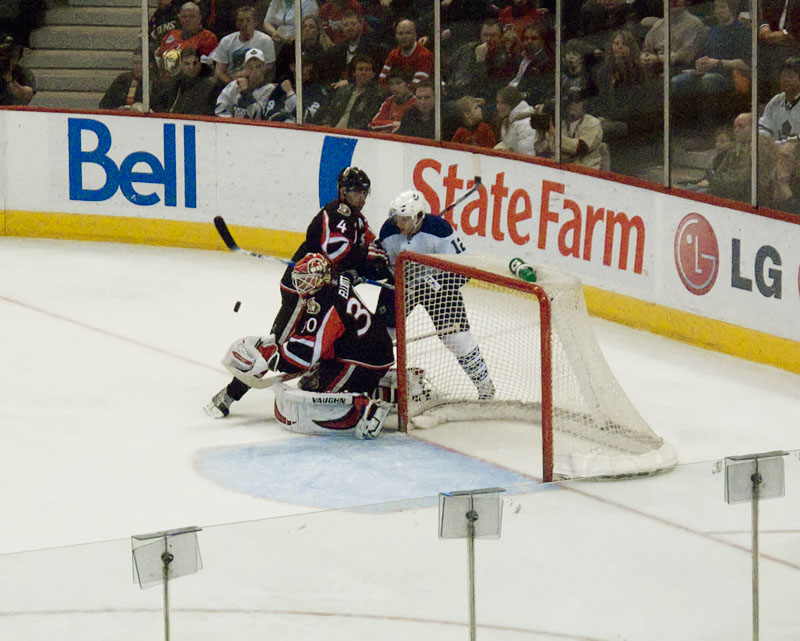
Obviously, you can clearly see the cameraman behind the goal, the faces on the players and in the crowd, and lots of details on their equipment. So what's not to like? I'm quite happy.
The only shot I posted at 800iso is the aftermath of the only Toronto goal. I was distracted and spun around to shoot it, so there is softness due to movement along with the natural softness of the high ISO. Still, it is acceptable. Plenty of detail is still visible.
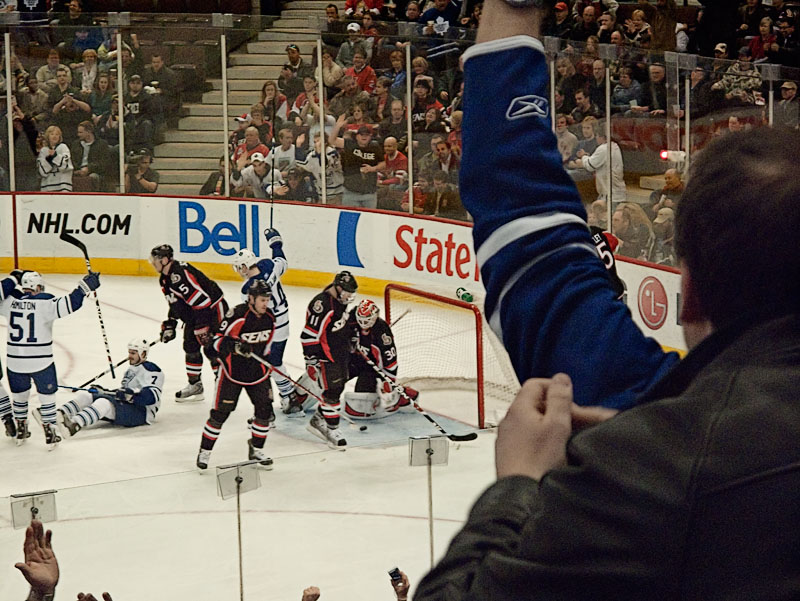
If you want to see how well this camera retains detail under these conditions, have a look at this crowd shot when the mascot made his appearance at the bench. The hair on these people clumps a bit, as is unavoidable, but there is still the feeling that you are looking at hair and not a helmet :-)
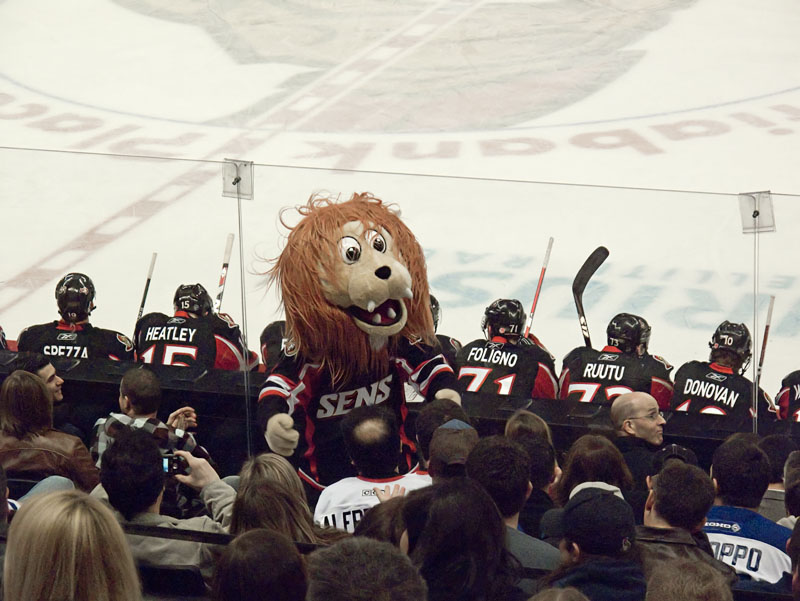
I was lucky enough to catch Alfredsson in the act of scoring the first goal. My shutter speed was slow enough at that time (1/200s) that the puck is simply a blur. But this one ends up in the net and 1 second later the audience is up and screaming.
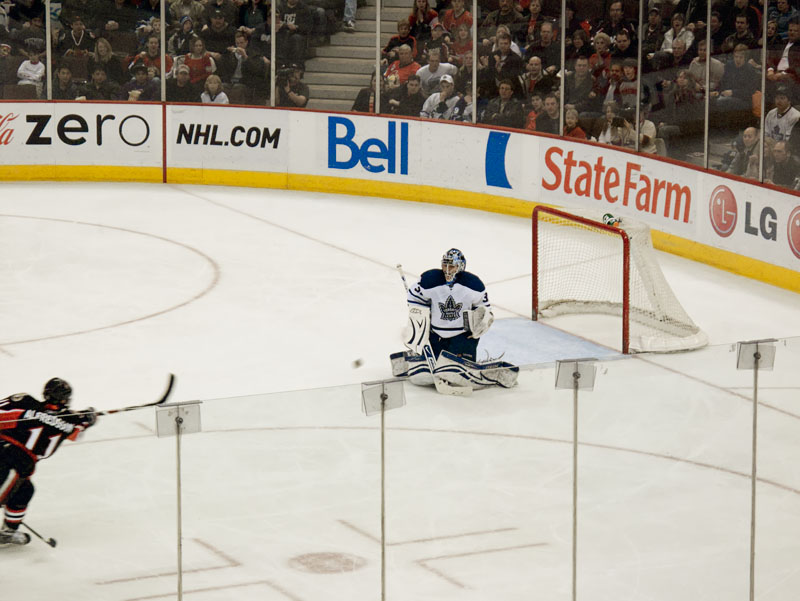
Despite the fairly slow shutter, note the very fine detail in the audience's faces. This is what I noticed about the G10 when shooting the concerts in late 2008 ... and those were done in jpeg. Here, I find RAW really makes a difference, despite the excellence of Canon's jpeg engine.
Here's another save by Elliot, protecting what is now a 2-1 lead for Ottawa. On this one, you can see the puck as a blur just below his blocker (right hand.) I had raised the shutter speed to 1/250s and I think it makes for a slight improvement in acuity. Of course, the fact is that each shot is subject to the technique used and the slight statistical variance that stabilization will produce. So who can say why some images are extremely sharp while others are just slightly less sharp.
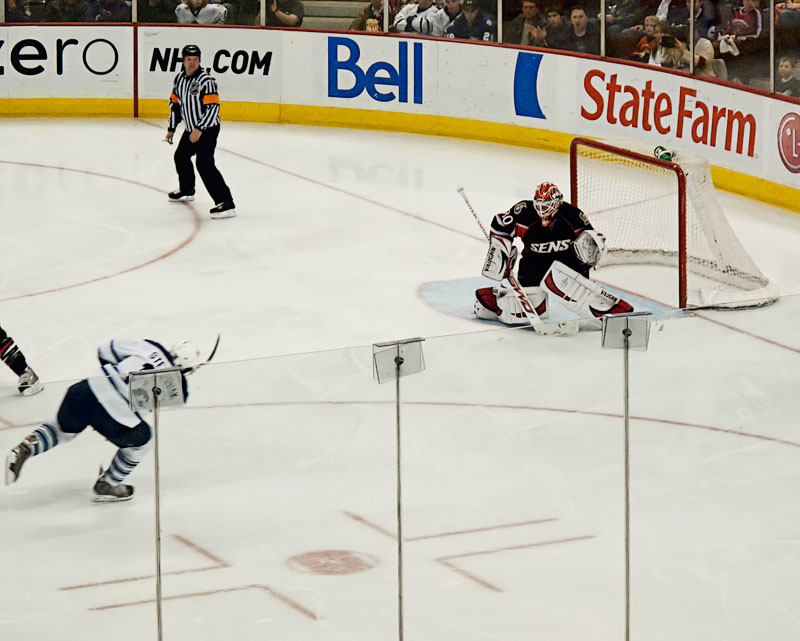
And finally, here's a somewhat cropped image of Daniel Alfredsson taking a spin on the ice after being named 1st star of the game. The detail and smoothness of this image is really something in my opinion. I am very pleased. I shot it at 1/320s, which I eventually found to be the best compromise between exposure and crispness.
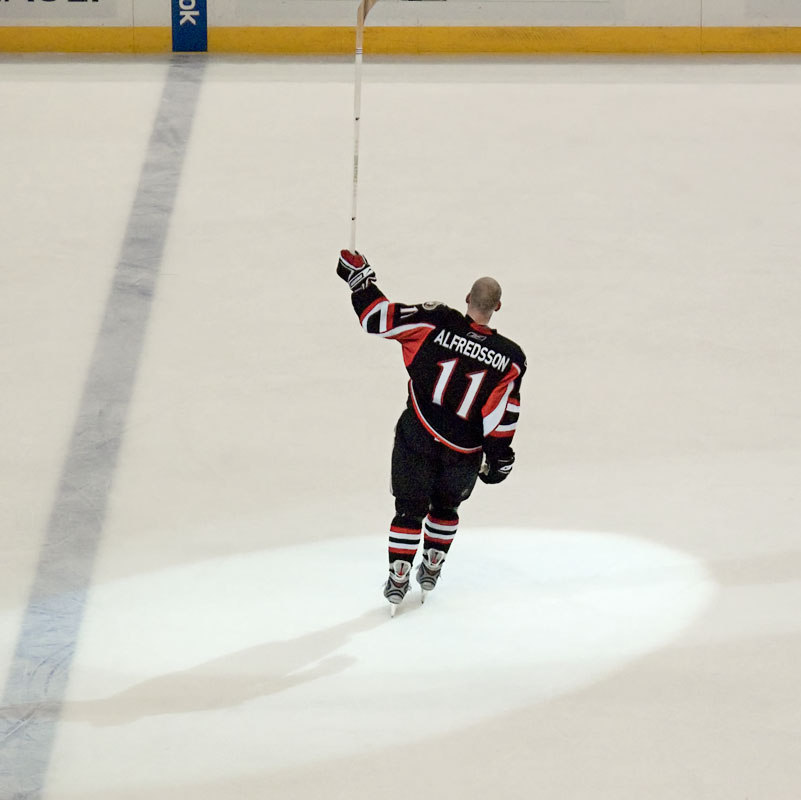
If you want to see the whole series, go here.